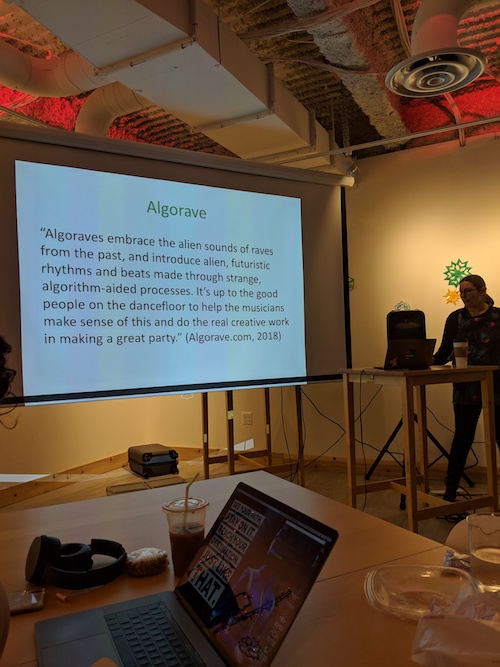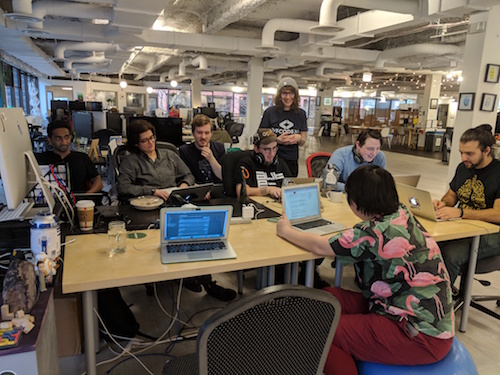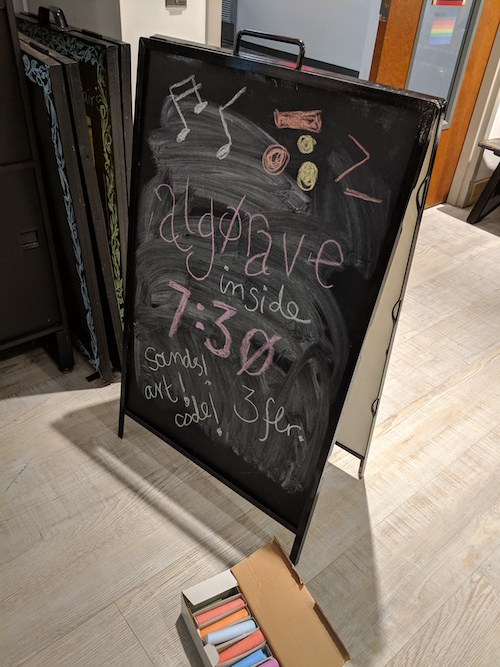On Friday night, I hosted the first algorave in Philadelphia at Indy Hall, featuring artists from LiveCode.NYC. The next day, they taught a workshop (10 attendees) where we learned about how to do live code ourselves.
Here’s a clip from Friday’s show, featuring Codie (warning: involves some flashing lights).
What’s Live Code?
Live coding has a lot of definitions on the net, but I would say that it’s using programming to make something (live, and changing it live). If you’ve asked me in real life lately, right now my answer is something like “using programming to make music” (but that’s not quite right, and excludes visualists and other live coders) or a way too long explanation I gave about using your computer at a synthesizer (that happened at a Christmas party Saturday night).
What happened at the workshop
In the workshop, Kate Sicchio led the introduction on what live coding is (clearly superior to my above definition), so I’ll share some of those resources in case that helps you wrap your head around it. However, I feel like attending an algorave (we’ll get there) is the best way to understand it.
In terms of “who’s the organizing body,” TOPLAP is an organization founded in 2004 centered around live coding, and a manifesto draft was written soon after. TOPLAP maintains an “awesome list” of live coding resources.
Algoraves
According to Kate, the first algorave was in 2012, with the first one in the US being in either 2015 or 2016 (under friendly contention).

In short: an algorave is a music/visuals/dance show. I don’t really want to tell them that raves aren’t exactly something of the past (the photo references “sounds of raves from the past”), but that’s a tangent for sure.
Not all algoraves are run the same, but in general, people project the code that is being run so that you can read it. For example, here’s Messica Arson’s code in FoxDot.

indy_hallAt the show on Friday, all of the bands involved a musician and a visualist (someone making live visuals using programming), but I don’t think that’s necessarily a rule.
Tools from the workshop
After the introduction, we took a short break, and then heard about three tools that would be covered/available at the workshop that day, so that people could choose what they wanted to focus on. We split up into three groups after that, and some people also chose to work in one group, float to another, float back, in that way. It felt a lot like a hackathon, in the absolutely chillest sense of the term.
Warning: live code visual tools and videos tend to involve flashing lights and color and may not be appropriate for those with sensitivities in that area. The first tool presented was Hydra, the visual tool taught for the day. Notably, you can try out Hydra in your browser. I didn’t play with this nearly at all (I find visuals pretty intense), and was more interested in the musical tools.
Next up was TidalCycles. This is what I learned, and what I plan to keep playing with. Like many live coding musical tools, it’s built on top of SuperCollider, which lets you use your computer like a synthesizer (which is really cool). It’s writing Haskell, but that makes it sound drastically more intimidating than it is.

Finally, Melody shared a bit about Sonic Pi, and has really awesome resources she made for the workshop. I didn’t play with it myself, but enjoyed the set at the end by my pals who used clips of JFK talking about the moon landing in their set.
At the end of the workshop, we took some time to throw our own little algorave, performed by people who had just learned how to do things that day.
Making the workshop happen
My dear, crushingly talented, friend/programmer/artist Sarah Groff Hennigh-Palermo is the visualist for the band Codie and I’ve loved hearing about her adventures with the band and the LiveCode.NYC community.
In my world, I’ve been quietly hobby-ing with electronic music for a little over two years, and I started to develop a strong suspicion that live code could be very fun for me, combing these two interests in quite a direct way.
It’s a little more than that too — the ethos of live code is about making humans important in programming, about sharing programming as art (not just “provide business value”). It’s weird and arty and noisy.
So I told Sarah “I want to make this happen” and so we did!
I talked to Indy Hall, and especially since the space has hosted many an art show, it was only a little difficult to talk about convincing our building that hosting something with the word “rave” in it was totally copacetic.
Sarah worked with her collective to make a schedule and do logistics on their end, and I got the space set up and did promotion and all those cat herding activities I haven’t done in a while. I had a lot of help, with special and particular (but non-exclusive!) thanks to Adam, Anaia, Rob, Sean, Monty, JB, and Haele.
How to run your own
It was so wonderful having the LiveCode.NYC collective down! The good news is that they’re willing to do that again, so get in touch with them if you have interest in bringing this workshop to your space/conference/jam.
There are also quite a few live code artists around the world, so depending on your geography, it might be very possible to put together an algorave in your area!

Correction: A previous version of this post said the live code manifesto was written at or after the Dagstuhl Seminar, the post has since been updated to reflect that the manifesto was written soon after 2004.
One Reply to “Algorave and Learning with LiveCode.NYC”